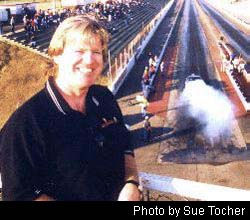
The Price of Success
8/8/06

 ust three or four years ago when I first began paying close attention to the burgeoning Outlaw 10.5 movement here in the deep south, I’d typically see two dozen or more entries at a $5,000-to-win race; most rigs in the pits were probably on par with that of a serious Sportsman racer; and whatever spare parts they could carry or borrow are what got an entrant through the weekend. Now, it’s getting to be a real challenge to fill a 16-car field, several teams have huge tractor-trailer or “toterhome” based rigs, and if there’s not a spare engine on board, they’re probably under-prepared—or at least racing from a distinct disadvantage.
ust three or four years ago when I first began paying close attention to the burgeoning Outlaw 10.5 movement here in the deep south, I’d typically see two dozen or more entries at a $5,000-to-win race; most rigs in the pits were probably on par with that of a serious Sportsman racer; and whatever spare parts they could carry or borrow are what got an entrant through the weekend. Now, it’s getting to be a real challenge to fill a 16-car field, several teams have huge tractor-trailer or “toterhome” based rigs, and if there’s not a spare engine on board, they’re probably under-prepared—or at least racing from a distinct disadvantage.
Unfortunately, the “outlaw” nature of Outlaw 10.5 racing is both its attraction and its curse. With few rules other than for safety and nearly any engine or power-adder combination allowed, turbos do battle against nitrous-injected and supercharged combinations, and that freedom naturally lends itself to experimentation.
For instance, one prominent turbo master recently debuted a new, promising twin-turbo, big-block combo and the 10-wide community is anxiously awaiting the arrival of a 900 cubic-inch nitrous motor on the scene. And while it’s great to have a class that encourages such technological marvels, two words come to mind in describing their impact on the sport: expensive—and exclusive.
Make no mistake about it, no matter how much propaganda is spread about Outlaw 10.5 cars being “just like the muscle cars you remember,” a competitive 10-wide entry is a purpose-built racecar in every sense. In fact, cars built just a few years ago are essentially worthless in the class today, where a $100,000-plus, professionally designed and
It just seems to me that Outlaw 10.5 is quickly becoming the “nitro class” of so-called street-car racing, where a big bank account is the most important factor for entering the fray. Especially with the restrictions placed on sponsorship, it means only those with the personal wherewithal are able to race the class and if (when?) their personal well runs dry they’ll fall by the wayside, just as we’ve seen in the nitro ranks so many times over the years.
And not only from the racers’ standpoint, I have to wonder how long these escalating costs can be sustained by promoters and track owners, too. Racers naturally want (need) increased purses when they’ve increased their investment, but for bigger purses promoters need more income. That’s got to come from entry fees and/or spectator admission, but with declining car counts and a general malaise in live attendance it’s a difficult circle to close.
